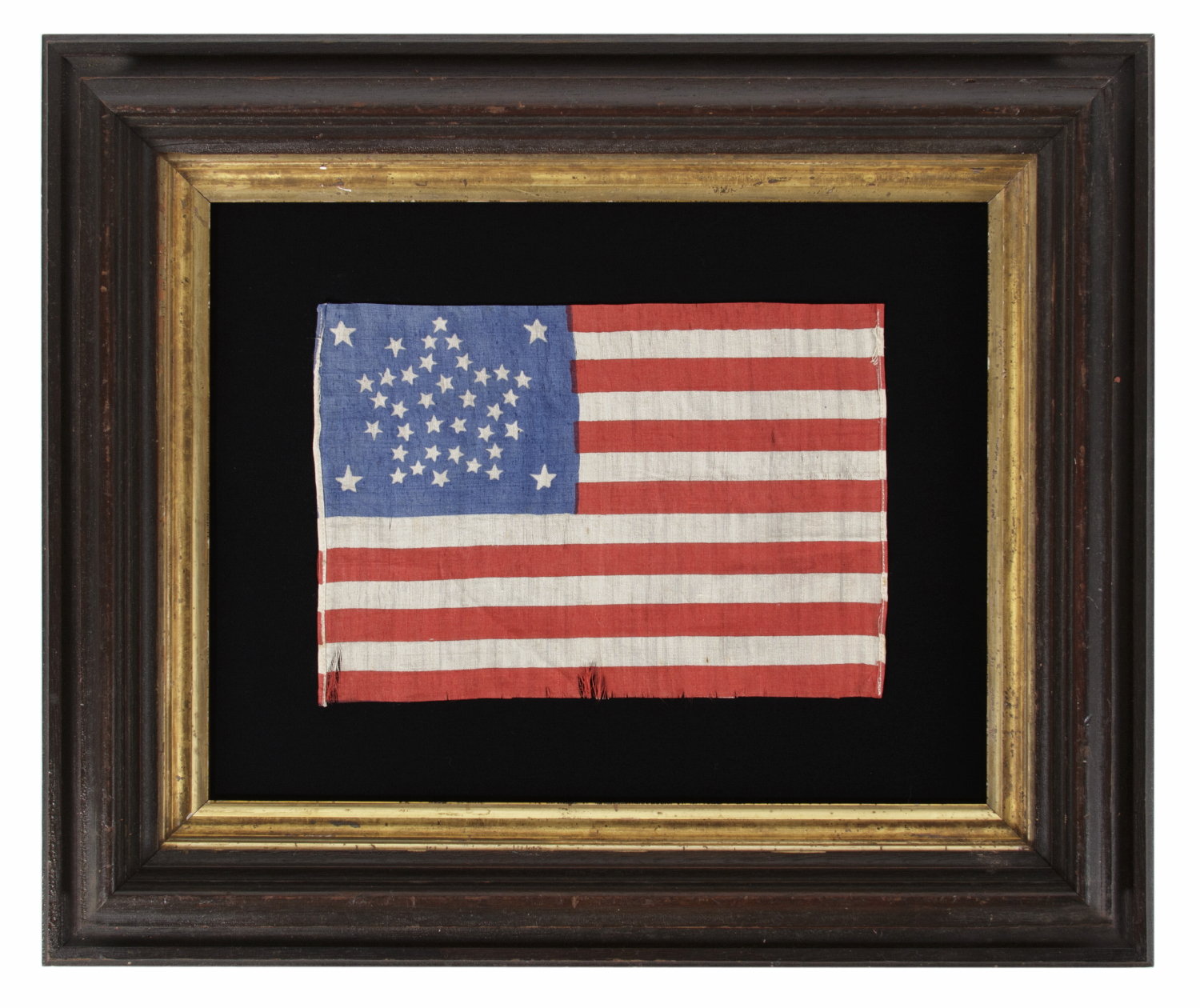
| |
38 STARS IN A RARE AND BEAUTIFUL VARIATION OF THE "GREAT STAR" PATTERN, COLORADO STATEHOOD, 1876-1889 |
|
| Available: |
Sold |
| Frame Size (H x L): |
15.5" x 18.75" |
| Flag Size (H x L): |
6.75" x 9.5" |
|
| Description....: |
|
38 STARS IN A RARE AND BEAUTIFUL VARIATION OF THE "GREAT STAR" PATTERN, COLORADO STATEHOOD, 1876-1889:
38 star American national parade flag, printed on silk. The stars are arranged in a variation of what is known as the "Great Star" or "Great Luminary" pattern, so that they form one large star. The pattern is also sometimes called the "Great Flower" and one can see why this term is applicable here. Note how the arms of the stars are open and slightly conical, like petals, and that there is a circular wreath in the center.
Among flag collectors, the Great Star configuration is perhaps the most coveted geometric pattern. It seems to have came about shortly before 1818, when Congressman Peter Wendover of New York requested that Captain Samuel Reid, a War of 1812 Naval hero, help to create a new design that would become the third official format of the Stars & Stripes. The primary concern of ship captains was that the signal remained easily recognized on the open seas. Reid’s concept of placing all the stars in a star-shaped pattern would have kept the constellation in roughly the same format as the number of states grew and more stars were added, in a distinct design that could be quickly identified through a spyglass. Though his proposal was rejected by President Monroe due to the increased cost of arranging the stars in this manner, the Great Star was produced by anyone willing to make it. Its rarity today, along with its beauty, has driven its desirability among collectors.
Colorado became the 38th state on August 1st, 1876. This was the year of our nation’s centennial of independence from Great Britain. Although 37 was the official star count for the American flag in that year, flag-making was a competitive venture, and no one wanted to be making 37 star flags when others were making 38’s. It is for this reason that 38 and 13 stars (to represent the original 13 colonies) are the two star counts most often seen at the Centennial International Exposition, the six-month long, World’s Fair event, held in honor of the anniversary, in Philadelphia. In addition, some flag-makers were actually producing 39 star flags, in hopeful anticipation of the addition of another Western Territory. The 38 star flag became official on July 4th, 1877 and was generally used until the addition of the Dakotas in 1889.
This particular variation seems to be unique to 38 star parade flags. Note how it includes a star in each corner of the canton, and a star between every arm except one. This blank space was purposeful and left open for the much-anticipated addition of another Western Territory, most likely the Dakota Territory, which arrived on November 2nd, 1889, as two separate states.
Mounting: The solid walnut molding dates to the period between 1860 and 1890, has dark, original surface and a gilded liner. This is a pressure mount between U.V. protective Plexiglas and 100% cotton twill, black in color. The cotton was washed to remove excess dye. An acid-free agent was added to the wash to further set the dye and the fabric was heat-treated for the same purpose.
Condition: There are two areas of minor to moderate breakdown in the bottom two stripes and there is a tiny split below the canton. Overall condition is a 9-out-of-10 for a silk flag of this period, however, and the colors are excellent. Many of my clients prefer early flags to show their age and history of use. |
|
|
|
| Collector Level: |
Advanced Collectors and the Person with Everything |
|
| Flag Type: |
Parade flag |
|
| Star Count: |
38 |
|
| Earliest Date of Origin: |
1876 |
|
| Latest Date of Origin: |
1889 |
|
| State/Affiliation: |
Colorado |
|
| War Association: |
1866-1890 Indian Wars |
|
| Price: |
SOLD |
|
| |
Views: 2855 |
|
|
|

